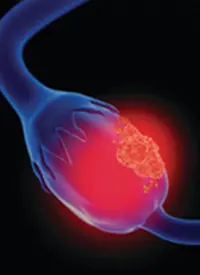by Caroline Seymour
The combination of abemaciclib and fulvestrant led to encouraging responses when used as neoadjuvant therapy which translated to high complete gross resection rates in patients with advanced, low-grade serous ovarian, fallopian tube, and peritoneal carcinoma.
The combination of abemaciclib (Verzenio) and fulvestrant (Faslodex) led to encouraging responses when used as neoadjuvant therapy which translated to high complete gross resection rates in patients with advanced, low-grade serous ovarian, fallopian tube, and peritoneal carcinoma, according to findings from a phase 2 study (NCT03531645) presented at the 2022 ASCO Annual Meeting.1
The results showed that among all patients (n = 15) who had undergone at least 1 scan, most had achieved a partial response (PR; n = 7; 53.3%) or stable disease (SD; n = 6; 40%). One complete response (CR) was reported (6.7%), translating to a best objective response rate (ORR) of 60% (n = 9). No cases of progressive disease (PD) occurred.
 Neoadjuvant platinum-based chemotherapy has modest activity in low-grade serous ovarian, fallopian tube, and peritoneal carcinoma, with an ORR of 11% and a complete gross resection rate of 38% at the time of interval cytoreductive surgery.
Neoadjuvant platinum-based chemotherapy has modest activity in low-grade serous ovarian, fallopian tube, and peritoneal carcinoma, with an ORR of 11% and a complete gross resection rate of 38% at the time of interval cytoreductive surgery.
Notably, low-grade serous ovarian, fallopian tube, and peritoneal carcinoma displays similarities to hormone receptor–positive breast cancer, sharing in clinical benefit from endocrine therapy in the recurrent and maintenance settings.
Because of the activity of CDK4/6 inhibitors plus antiestrogen agents in hormone receptor–positive breast cancer, investigators launched a pilot phase 2 study to evaluate the clinical benefit of neoadjuvant therapy with abemaciclib and fulvestrant in women with advanced, low-grade serous ovarian, fallopian tube, and peritoneal cancer.
The study enrolled women with unresectable, untreated stage III or IV low-grade serous ovarian, fallopian tube, or peritoneal carcinoma.
Patients received 150 mg of oral abemaciclib twice daily plus 500 mg of intramuscular fulvestrant on day 1 and 15 of the first 28-day cycle, followed by administration on day 1 of the remaining 7 cycles. Pre/perimenopausal patients also received 10.8 mg of subcutaneous goserelin every 12 weeks for ovarian suppression.
After patients completed 8 weeks of combination treatment, they underwent response assessment. Unresectable patients with SD or PR received another 8 weeks of the combination until CR or resectability was reached.
Resectable patients with CR or PR underwent interval surgery followed by 4 cycles of adjuvant abemaciclib and fulvestrant until progression or a maximum of 16 weeks of adjuvant therapy was reached. Patients with PD had the option to undergo biopsy and receive standard-of-care treatment off study.
Following interval cytoreductive surgery and completion of adjuvant treatment, patients switched to maintenance letrozole (Femara).
The primary end point of the trial is clinical benefit rate.
Additional results indicated that approximately half of patients (n = 7; 47%) had undergone surgical resection. Most patients (n = 5; 71%) achieved complete gross resection and all (n = 7) achieved optimal cytoreduction. Five patients had switched to letrozole maintenance at data cutoff.
The combination was also found to be tolerable. Grade 3 or 4 adverse effects potentially related to abemaciclib occurred in 2 patients (13.3%) and included acute kidney injury (6.7%) and neutropenia (6.7%).
Investigators plan on confirming these results in a larger study population and exploring potential biomarkers of response, including the expression of the estrogen receptor, progesterone receptor, and Ki-67 index.
Reference
Cobb LP, Davis J, Hull S, et al. A pilot phase II study of neoadjuvant fulvestrant plus abemaciclib in women with advanced low-grade serous carcinoma. J Clin Oncol. 2022;40(suppl 16):5522. doi:10.1200/JCO.2022.40.16_suppl.5522
This article was published by Onc Live.


